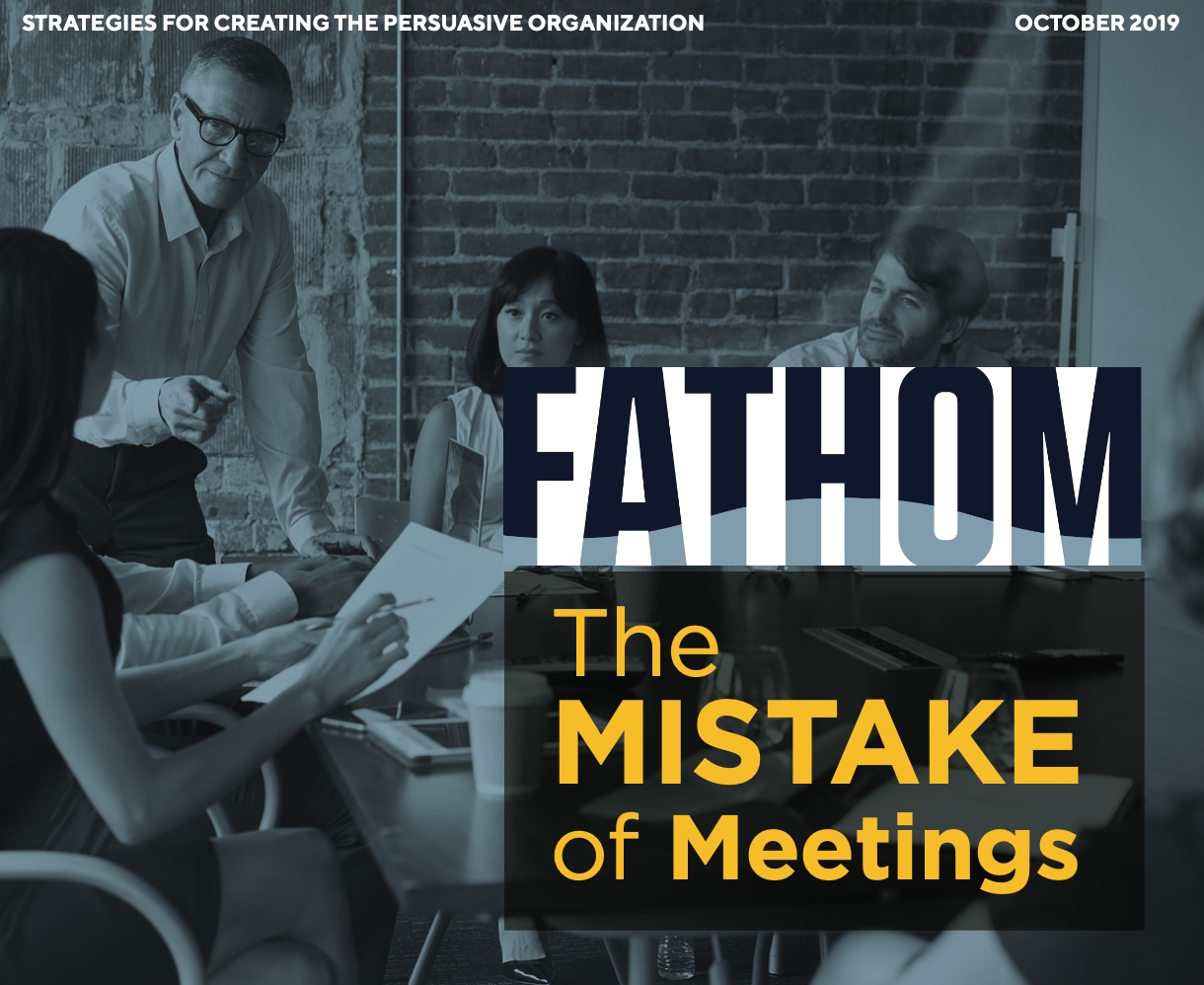Read this issue in its original magazine format.
The High Cost of the Conference Room
Your company has a problem—a massively expensive and pervasive problem that starts at the top. Yes, this is a problem that begins with you.
But the good news is that there is a solution. And the solution, just like the problem, also starts with you.
That problem? The relentless proliferation of bad meetings: meetings without clear purpose, that have no defined limit, and that result in more confusion. And unequivocally, the reason bad meetings are so common is because leadership so often allows bad meetings to happen. A culture of bad meetings develops when leadership fails to set clear guidelines and expectations, allows meetings to be scheduled without oversight or consequence, and runs their own meetings poorly.

In other words, if executives and managers convene or lead meetings that are badly structured, are overly long, lack a concise agenda, and require unnecessary attendance, that’s how meetings will be run throughout the organization. Even if leadership sets out goals or provides training to rein in the meeting madness, the suggested changes will only be effective if what leadership does reinforces what it says.
We have guided more than ten thousand people through our training programs, and in nearly every workshop we ask the same question: In a typical week, how much of your time is wasted in bad meetings, conference calls, or poor presentations? The answers we hear are astonishing: 50%, 60%, even 90%! (If anyone’s boss is in the room, the numbers are reliably lower.) If you throw out the outliers on either end and average the rest, we conservatively hear a number around 40%.
Translation? That’s two outof five days wasted in meetings with no clear agenda, action items, or resolution. That number sounds bad enough. But let’s make the problem even more “real” by monetizing it. Consider the salaries of every participant in the room and take 40% of that number. Now, spread this same calculation across your entire organization. You get the idea… wasting 40% of the time of everyone inside your organization is a very expensive problem.

What’s more, this is a problem for the costliest members of the organization, since upper management spends as much as 50% of their time in meetings.1 And it’s not just time inside the conference room that gets wasted. Researchers have found that the anticipation of a meeting can decrease productivity well before the scheduled start time.
According to studies, the organizational cost of unproductive meetings ranges anywhere from $37 billion3 to $213 billion4 annually. (The Harvard Business Review has created a handy calculator to find your own costs.5) A Bain & Company analysis showed that one company’s weekly status meeting of senior executives cost 300,000 person hours annually through the cascading meetings held to support that single meeting, and that didn’t even include the hours employees devoted to prepping for each of these meetings.
But we are not done capturing the scope of the problem. Now factor in the opportunity cost— what more productive, profit-generating pursuits could have occurred during this time? And, more amorphously, what is the cost to your personnel’s morale? We believe this is the most insidious and value-destructing cost of all, and the negative effects are cumulative. Bad meetings can feel to some like a daily corporate root canal. Twenty years ago, a week’s vacation at the beach might have been enough of a cure. But is that enough of a cure today? We don’t think so. As the problem becomes more acute and aggressive, simple, short-term cures are no longer enough. We need to attack the root cause of the problem.
Why do companies struggle so much with meetings? It may be because we all know that no organization can be successful without communication. And a common truism holds that the most efficient way to communicate is by gathering together in a room or virtually to discuss strategy, divide up tasks, or learn important information. Yet most of us feel our time is wasted in poorly run meetings. We are unclear why we are in the room, and we are demoralized by the strain on our time.
In other words, in most organizations, a commitment to better communication usually equates to more time spent in meetings and on conference calls.
We are going to challenge that behavior and the assumptions behind it. Because we believe there is a communication blind spot in most organizations, and the typical communication behaviors are inherently flawed. Furthermore, we believe this problem is cultural, and that both the problem and the solution start at the top.
Top-Down Dysfunction
We all feel this problem. That too many meetings, too many bad meetings, create dissatisfaction and disengagement isn’t a secret. Yet the problem persists. We recognize it, but we can’t solve it. Why?
It may have something to do with the increasing complexity and flexibility in corporate structure, and the rise in identification of teamwork as a core value. For years, corporate structures were strictly hierarchical: the executive suite made decisions, and employees executed those decisions. But as society changed and commerce became more global, corporations became more diversified, and our access to information and means of communication exploded, corporate structure had to evolve. The late 1970s saw the rise of the matrix organization, mirroring the complexity of a multi-pronged business with a parallel-reporting org chart that allowed companies flexibility and creativity in tackling problems.
Consensus emerged as a key element—in both a positive way that ensured that corporations didn’t become bogged down in silos, and in a negative way that allowed managers to delay or dilute decision- making.7
But even as the tools to achieve consensus and collaboration have improved—technology such as direct messaging, the proliferation of design thinking—our tactics have not caught up. Meetings and conference calls remain the tool of choice to communicate and strategize, which means that employees, from the executive suite down, may be called together two or three times as often as before.
Many managers see meetings as a bottom-up problem and a contextual one – the wrong time, a confusing topic, or a bad presenter. But, while all these factors can affect the outcome, the real problem is systemic. As Christopher Bartlett and Sumantra Ghoshal noted in their analysis of matrix organizations, a matrix structure needs to be complemented by “organizational physiology—the systems and relationships that allow the lifeblood of information to flow through the organization. They also need to develop a healthy organizational psychology—the shared norms, values, and beliefs that shape the way individual managers think and act.”
Managers also often think that all they need to do is train people in how to give better presentations (and that they themselves don’t need any training at all). And, yes, it is true that better communication skills help. There are specific, measurable skills that The Latimer Group has systematized into a very effective curriculum, and we’ve seen that curriculum radically change organizations’ communication for the better.
However, the most important element of training is this: organizations that see the fastest, most dramatic return on investment are the ones that make a commitment from the very top.
As with any systemic problem, the most effective solution is top-down. When managers and executives visibly and consistently commit to a change in how communication is organized, employees are quicker and more willing to incorporate that change into their own communication. Without public, enthusiastic endorsement (or even better… participation) from their boss, most employees will second-guess a new way of doing business. That’s why one of the most common questions we hear in our workshops is, “Is my boss taking this course?”
Making meetings, conference calls, and presentations more effective and more efficient isn’t difficult. But it does require preparation and practice to reframe your approach. And few employees will want to invest in that preparation and practice if they aren’t 100% sure that it will be met with approval (or, worse, if they fear that it will be met with disapproval). To solve the problem of bad meetings, the most immediately productive investment you can make is your own commitment to change.

Finding a Solution
Every organization has its own culture and its own systems, and the solution to ineffective meetings won’t always look the same from company to company. However, two important strategies must be in place for improvement to take place quickly and potently.
1. Articulate the solution you want to see: Leadership must be able to set out clear goals, expectations, and a common vocabulary in order for the entire team to visualize and achieve better communication. Leadership has to articulate behaviors that are non- negotiable. For instance:
Set a meeting budget. As Bain and Company describes it, “We will invest no additional organizational time in meetings; we will ‘fund’ all new meetings through ‘withdrawals’ from our existing meeting ‘bank.’” 9 In other words, people in the organization have a budget of time for meetings that they can call in a given time period, and they have to use that budget wisely.
Perhaps you could even set some consequences for consistently exceeding your budget.
Create frameworks for responsibility. Who needs to be in the room? Set a guideline requiring manager approval if a meeting exceeds a certain time-length or participant threshold. Encourage or require advance preparation. This will ensure that participants come into the room ready to engage. Don’t be afraid to cut meetings short if the discussion is no longer valuable.

2. Execute the solution consistently and clearly: Leadership needs to both understand the tools that the team uses to meet the goals and expectations for better communication, and to wield those tools themselves.
Create a culture of accountability. Consider setting penalties for unnecessary or unproductive meetings, and/or rewards for effective or beneficial ones. At the same time, make sure to allow mistakes to happen. If something goes wrong, find a way to evaluate what happened without being too punitive. Occasional mistakes or missteps are OK. Patterns of poor performance need to be addressed, but one-time issues are better used as ways to learn.
Lead by example. Follow all the same rules and expectations for preparation, agenda-setting, and concision. Commit to the same processes you have invested in for your team. At a minimum, you will build credibility by being in the trenches with your team.
Seek advice and coaching for yourself. If you have a hard time with self-evaluation, ask a trusted colleague (not a direct report) to give you constructive feedback. Better yet, bring in an outside coach, who can give you feedback unrestrained by familiarity or bias.
Set up a communication task force from among your team. Give a subset of your organization the authority to draft some norms. This could be highly empowering, and almost certainly produce better behaviors.
Continually assess how your expectations and frameworks are working. Do you see improvements? Are people back-sliding? Do certain goals no longer make sense? Check in with your task force?
Be transparent. Create better decision-making (and cut down on the need to convene) by empowering employees to make decisions themselves when possible. If as a manager you are transparent about how you resolved a problem, it allows your reports to resolve future problems more quickly.
When leadership behaviors shift to accomplish clear, achievable goals, the difference cascades through the company.
The most important change to improve meetings: leaders need to model the behavior they want to see. Yes, it will take a few extra minutes of your time, at least at first, to make thoughtful, conscious choices around what meetings occur, who attends them, and what they set out to accomplish. But this small investment of your time will save the wasted energy and resources of numerous employees and open up greater opportunity for creativity and focused thinking, while boosting quality of work and morale.
And it won’t only affect your reports. Remember, the problem of bad meetings ranks more highly for managers and executives than individual contributors. As a recent McKinsey report observed, “Your goal should be to treat your leadership capacity—a finite resource—as seriously as your company treats financial capital (an equally finite one).”10 Modeling better business communication will save your time and boost your morale too.
Three simple questions can help make an immediate and clear difference in the time spent in meetings:
Is this meeting necessary? Analysts have found that many companies waste time in redundant meetings (two or more committees devoting time to overlapping priorities) or informational sessions that could be condensed into a one-page handout. Make sure that the time commitment of pulling everyone into a room together is worthwhile.
What is the goal of the meeting? This seems like common sense, but many meetings have too broad or unclear agendas. Take five minutes to distill your agenda into the most direct, concise statement possible. Then make sure that every attendee knows the agenda when he or she walks into the room.
Who needs to be in this meeting? Be thoughtful about who attends what meetings. If someone isn’t going to be an integral, active participant, let her or him focus on other tasks. Meetings aren’t the enemy. Bad meetings are. And like so many other issues in the corporate landscape, the root of the problem is communication. But with training, practice, and preparation, anyone can improve their communication. And when an organization commits to better communication from the top down, the effects can be immediate and immensely impactful. Time is saved. Money is saved. Frustration is reduced. Creativity and effectiveness are unleashed.
Notes from our Team:
When we think about this problem at The Latimer Group, we start close to home: our own search for a balance between efficiency and collaboration, between muscling through our agenda and allowing ideas to flow. We are a small company and yet we still struggle to find the right meeting cadence, and the adequate amount of pre- meeting prep. When we extrapolate our experience to companies 10, 100, or 1000 times our size, the potential for drag, waste, and demoralization increase exponentially. For our team at The Latimer Group, setting a clear structure around meetings and decision-making has been vital.
First, the entire team needed to understand our common goals and how involved leadership needed and wanted to be in day-to-day decision-making. We have a very talented team, but innovation wasn’t happening as smoothly as it could have because we hadn’t delineated the process behind implementing change. We all worked together to research frameworks around decision-making and spent hours together at an off-site creating a broad set of priorities, and the corresponding principles, or specific behaviors, to support those priorities. The ultimate goal: to empower people to make decisions, and thus reduce the need to meet around the conference table or on the phone.
We also clarified which areas were firmly reserved for senior leadership to decide, and which areas needed to involve senior leadership early on. Beyond those realms, the team was empowered to make their own decisions and loop in who they needed when they felt they needed them.
All these frameworks combined allowed us to streamline the way we meet and strategize. We have a regular monthly meeting with the full team. Otherwise, meetings are scheduled at our own discretion. We continuously assess how the process is working. We accept that occasionally a problem might arise or a mistake might be made. But our time is more open, the possibility for innovation is greater, and each member of the team feels ownership over their projects and supported in taking initiative.

Explore other Issues of FATHOM: Strategies for Creating the Persuasive Organization
- The Mistake of Meetings: FATHOM Issue 1 (2019)
- Establishing Repeatable Performance in Communication: FATHOM Issue 2 (2020)
- Adapting to Virtual Communication and Embracing Its Strengths – FATHOM Issue 3 (2021)
- Best Practices for Strong Virtual Communication – FATHOM Issue 4 (2021)
- The Biggest Roadblock to Organizational Success: Poor Internal Communication: FATHOM Issue 5 (2022)
- Communicating to Belong: FATHOM Issue 6 (2023)
- Building Communication with the Next Generation: FATHOM Issue 7 (2024)
- How to be Heard in a Noisy World: FATHOM Issue 8 (2024)
References:
1 Larsen, Dana. 2017. “Are meetings costing your business too much money?” SAP Concur, January 17, 2017. https://www.concur.com/news-
room/article/are-meetingscosting-your-business-too-much-money
2 Woollaston, Victoria. 2018. “Down with meetings! Studies confirm appointments make us less productive and mess with our workflows.”
Alphr.com, May 24, 2018. https://www.alphr.com/business/1009422/meetings-lessproductive?fbclid=IwAR0xnmduqJsDaS6mT3lIqxd-
d8GQ4YwDLHWurv6OszMfvbbOrYaROIoJb3S
3 Larsen, Op.Cit.
4 Mroz, Joseph E., Joseph A. Allen, Dana C Verhoeven, Marissa L. Shuffler. 2018. “Do We Really Need Another Meeting? The Science of Work-
place Meetings.” Current Directions in Psychological Science. October 19, 2018.
5 “Estimate the Cost of a meeting with This Calculator.” Harvard Business Review. January 11, 2016. https://hbr.org/2016/01/estimate-the-
cost-of-a-meeting-with-this-calculator
6 Mankins, Michael, Chris Brahm, and Greg Caimi. 2014. “Your Scarcest Resource.” Harvard Business Review, May 2014. https://hbr.
org/2014/05/your-scarcest-resource
7 Davis, Stanley M. and Paul R. Lawrence. 1978. “Problems of Matrix Organizations.” Harvard Business Review, May 1978. https://hbr.
org/1978/05/problems-of-matrix-organizations
8 Bartlett, Christopher and Sumantra Ghoshal. 1990. “Matrix Management: Not a Structure, a Frame of Mind.” Harvard Business Review,
July-August 1990. https://hbr.org/1990/07/matrix-management-not-a-structure-a-frame-of-mind
9 Mankins, Op. Cit.
10 De Smet, Aaron, Gregor Jost, and Leigh Weiss. 2019. “Want a better decision? Plan a better meeting.” McKinsey Quarterly, May 2019.
https://www.mckinsey.com/businessfunctions/ organization/our-insights/want-a-better-decision-plan-a-better-meeting






Comments